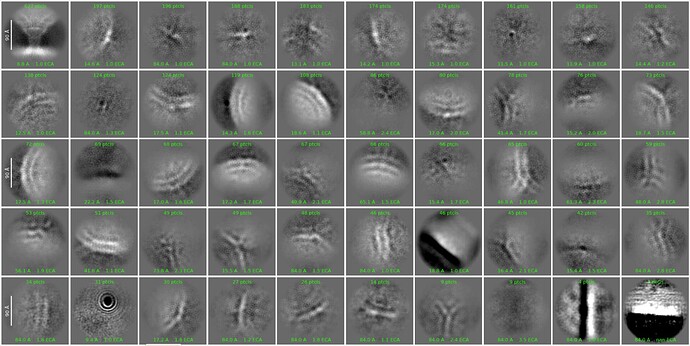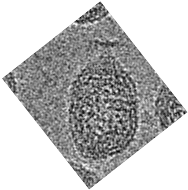I am moving a map (200px) together with its particles into the center of the box. So I used the volume alignment tool and input the center of map as “100,100,100”. But the aligned map seems to deviate greatly from the center in Z direction shown as below.
Is there anything wrong with my input center?
Hi @rainfieldcn! What did the map look like before recentering?
But in this case you would want to specify the center as something like 100,120,130, no? You want to specify the coords in the starting reference frame - which will then be translated to the center of the box (this doesn’t explain your observation, as if you input the existing center as the position to translate to it shouldn’t do anything).
If you have a mask matching your density, there is an option in volume alignment tools to recenter on the mask - that is probably the easiest way to get the result you seek.
Cheers
Oli
I am using v4.4.1. The input field is “3D Coordinates of new center (voxels)” , so I input the center of box.
And there is no “center on mask center” option.
Is this function available in the newer v4.5.1 ?
Thanks!
Yes I can see how it is confusingly worded - but it means the new center in the reference frame of the old box - so where you want the new center to be. In this case, it looks like you want to move the density at 100,120,130 to the center of the box (100,100,100), correct?
Yes, I believe the center on mask option was added in 4.5
I understand it now. I’ll update to v4.5 when I get a chance.
Thank you very much!
Dear all,
I have a quick question regarding the shifting centre using volume alignment tool. There are a few problem I am facing, but I will go one by one.
So, the first thing first, am I doing it correctly? These are the results of re-centering before and after. Here, I have defined the new coords as 79, 79, 26. Reasonable?
- I have linked both the refined map and the particles to input
- I have ticked the box “Reassign UIDs” to the particle processing parameter
- The only warning I received as I didn’t specified the unit of the coords, so it considered as pixels (voxels).
I am raising this as on the next step I tried to extract with a smaller box (256 px) around the new centre (made sure that the “Recenter using aligned shift” box was ticked), but during the 2D, it turns out it didn’t extract from the area of interest adequately. For example, there were around ~4000 ptcls, but I ended up with only a few hundreds.
N.B. I have tried with a mask as well, but that I will discuss that separately. Another future discussion would be, this ptcls are probably wrongly aligned, as you could see my feature of interest on both sides - and that’s how they were in the 2D as well, which is not suppose to happen.
Hi @nameless_wonder, could I ask you for a bit more information on this issue?
First, could you let me know what pixel size your images are here?
I’m also hoping you could explain a bit why you want to move the particle so far off center.
Could you explain a bit more what you mean here? In what ways was it not adequate?
Do you mean that during extraction you lost several thousand particles, or that after performing 2D Classification the good classes had several thosand fewer particles?
Hi @rposert,
Thanks for getting back. Yes, we can discuss more details surely.
Pixel size is 0.82 A/px. I have extracted these with 1280 px box (particle diameter ~700 A), binned 8.
I want to do a focused reconstruction on a specific feature near the “new center”, as you could see in those images. So, the plan was to move the center, re-extract with a smaller box out of that shifted center, then 2D, 3D etc. with the shifted particles. Please comment if this is the right approach.
It extracted the exact same number of particles that were present in the map shown above (4515). But yes, after performing 2D classification, the (good) classes showing the feature of interest had only a few hundred of particles. I made sure that the refined map was created with particles having that feature. Please see the 2D classes below:
2D before ab-init and NU ref:
Ab-initio:
Volume 0
Volume 1 = 4515 ptcls
Then NU-ref, recenter, extraction with 256 px box size, and 2D:
The 1st class shows the feature and only having 617 ptcls (not all of them are good though). That’s why I commented “inadequate”.
Please comment.
Regards.
Hi @nameless_wonder, thanks for all that information! It’s very helpful.
I think what might be happening here is that the 2D classification is having issues because there’s a significant amount of denisty that extends up to (and beyond) the edge of the box. Generally, 2D Classification expects the entire particle to fit inside the box.
Have you performed Homogeneous Refinement of your particle before recentering? If so, rather than performing 2D Classification after recentering, you could try performing Local Refinement with a mask around your region of interest. This skips the problem of 2D Classification with recentered particles, provided you’re relatively confident that all or most of the particles in your recentered stack are high quality.
1 Like
Would also suggest 3D classification after local refinement, if low-quality particles are still suspected to be present.
Once I’ve symmetry expanded to work on a block/focussed refinement, I will never go back to 2D (except as an occasional sanity check with alignments off if working in RELION); it always seems to make things worse.
1 Like
Hi @rposert and @rbs_sci
Thanks to both of you. We had a down time with our cluster, and now will work on this.
Yes, I have done homogeneous ref or NU ref. Used volume alignment afterwards.
Before I go ahead with this, just to get an idea on this…
…have I done this right? Please advise.
For avoidance of uncertainty, I usually download the map and mask the area I’m interested in having centred. I also symmetry expand, if symmetry was imposed. Then Volume Alignment Tools can be used with “recenter to mask” (or similar) to shift the center point. Then, because I’ve seen odd artefacts with some data, I re-extract the particles with the shifts, remask and local refine/3D classify from there.
1 Like
Hi @nameless_wonder, it’s hard to say whether your recentering position is reasonable. It depends on what you want to center in your box, the box and pixel size, etc.
@rbs_sci’s recommendations above to make a mask around the region you’re interested in make sense and are a great way to be sure you’re re-centering on the exact place you want to be. You could also follow the process outlined here for finding a Local Refinement fulcrum position and use it as the volume recentering coordinate.
Dear @rposert and @rbs_sci
Thanks for your kind help. I am working on this.
However, this leads to the second problem I had with this particular dataset (not sure if this is the right thread to discuss, happy to raise another topic if needed).
So, as you can see in this raw image, the particle has a small t-shape feature on top.
Which is evident in the 2d and 3d as well.
However, unlike the real particles in the raw images, the 2d (and so does 3d) converged this feature on both ends. It turns out there was some kind of alignment issues during 2d classification. Any suggestion about solving this please? Thanks in advance.
N.B. it’s a Krios data collected with epu group afis strategy, and xml files were imported to CS, later optics groups were implemented with the exposure group utility job. Pixel size was 0.82 A/px and box size was 1280 px (binned to 160). Not sure if it is important, but this problem did not occur in relion. However, with this data, I want to do all the processing within CS. These were ran in v4.5 but now we have upgraded to 4.6.2.
To me, it looks like you are having an issue in ab initio - it looks like this should have Cn or Dn symmetry, but the z-slice looks broken and weird. Are you sure the initial model is correct? Have you applied some of the suggestions elsewhere on the forums for applying ab initio to high-symmetry particles?
Looking at that example particle, I think there is zero symmetry… to the point of wondering if subtomogram averaging might be the way to go instead.
The 2D looks like the particle are off-centre and “pair aligning” in two directions at the middle of the box, but not actually “real” (like the particle in the 2D class is mirrored)…
1 Like
Hi @olibclarke
These are kind of large viruses, I haven’t seen any symmetry being applied before. As explained earlier, my idea was to crop out and do a focus reconstruction on that tiny feature, where then I was planning to apply appropriate symmetry.
These were from my latest run. I am carrying forward with the 2nd one (albeit with that duplication in place).
Hi @rbs_sci
Is there any way to resolve this issue?
Possibly. How did you pick particles? If picks are well centred, you can try 2D classification with “Recenter 2D classes” disabled. I’ve had luck in the past with one dataset which liked “drifting off” because it was a ring shape. If picks are not well centred, that’s the first thing to fix… perhaps with manually selecting some particles to make absolutely sure they are centred exactly how you want them, then trying the above for 2D classification.
This works really well. I also had some luck recently with manually picking the feature I was interested in, getting a nice 2D in a small box and picking with that, and then being very, very particular about thresholding for Inspect Picks and what classes I selected from 2D classification. Took a bit of fiddling around, but worked in the end.
This one looks good I agree - but this looks quite different to the volumes you had in your original post
vs
I see what @rbs_sci is saying about that one boxed out particle, but based on the 2Ds it certainly looks like Dn symmetry to me… applying the correct symmetry for refinement of the whole particle may be worth trying (and you can then extract subparticles around the asymmetric “T” feature at the end and classify to find the right local symmetry).













